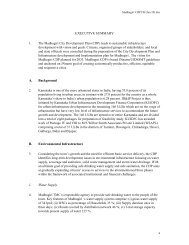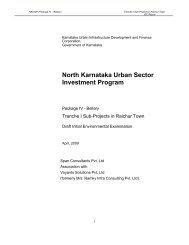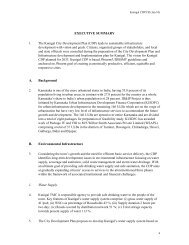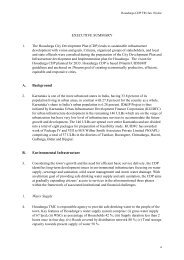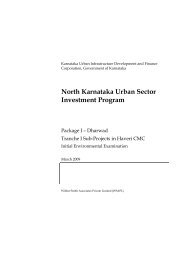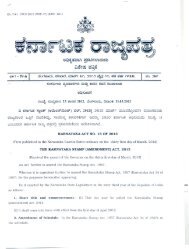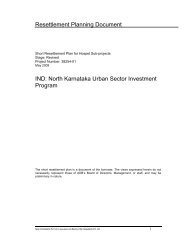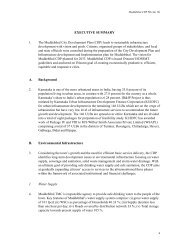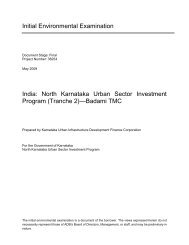KMWEEP-EA Final Report June 3 2008.pdf - kuidfc
KMWEEP-EA Final Report June 3 2008.pdf - kuidfc
KMWEEP-EA Final Report June 3 2008.pdf - kuidfc
You also want an ePaper? Increase the reach of your titles
YUMPU automatically turns print PDFs into web optimized ePapers that Google loves.
KARNATAKA MUNICIPAL WATER PUMPING IMPROVEMENTS IN SIX TOWNSENVIRONMENTAL AUDIT AND PREPARING ENVIRONMENTAL MANAGEMENT PLANFINAL REPORTC-4 Environmental SettingPhysiography and SoilLocated on vast expanse of gently undulating plain, the terrain drains towards south andsoutheast towards Bhima River located at 25 km away from the Gulbarga. The City is surroundedby small hillocks towards the north and northwest side. The general elevation in the region variesbetween 330 m and 650 m. The city is spread around Sharavana Basveshwara Lake, animportant natural water body.The city is located in the rich agricultural tracts of Krishna River basin and the soil is characterizedby fertile Block Cotton soil. The main geological formations seen in Gulbarga are Pleistocene andRecent (consisting of soil and laetrite, alluvium and recent conglomerates), tertiary (comprised ofdeccan traps and inter trappeans and intra-trappeans), puranas (composed of upper Bhimashales and sandstones), archean (comprising peninsular gneiss with associated youngergranites) and Dharwar schists. The characteristic rock types found are hard and compact rockscalled basalts. Overlying the Deccan traps and the Bhimas, there are thick spreads of black soil.In the area occupied by granites, the soil varies from loamy to sandy. Pebbles of chert, limestone,shale and granite are frequently found embedded in these soils. The kinds of minerals found inthe district include gold ochre, feldspar, gypsum and copper.Climatic ConditionsThe region experiences extreme climatic conditions with very high temperatures during thesummer and low during the winters. Although it is divided into three distinct seasons: summer,from February to July; monsoon, from August to September; and winter, from October to January;the city experience generally hot and humid climate with prolonged summer. The Temperatureranges from 40 o C to 16 o C. Humidity ranges between 40 percent and 60 percent. The averageannual rainfall is around 730 mm. The mean maximum humidity of the city is around 60% in themorning, with a minimum of about 40%. During monsoons humidity increases up to 70 percent inthe mornings and 50 percent in the evening. The predominant wind direction in Gulbarga is fromwest to south-west in the monsoon season and from east to north east during winter seasons.Water ResourcesKrishna and Bhima are the major rivers of Gulbarga region. Kagina River originates in AndhraPradesh and joins Bhima in the district. Bennithora, a tributary of Bhima, flows through the district.While Bhima and Bennithora Rivers are the major water supply sources of Gulbarga, none ofthese flow through the city. Kotnoor Nala is a major natural stream, flows from north to south, inthe eastern part of the city and joins Bhima River at about 1 km upstream of the intake well forwater supply to the city. Sharavana Basaveshwara Lake is an important water body in the cityaround which the city has developed.KSPCB monitors ground water quality at about 11 locations in Gulbarga and at 3 locations atBhima River. Analysis of information on water quality for the past 3 years indicates that the waterquality is well within the drinking water quality standards prescribed in IS 10500. The criticalparameters such pH, Chlorides, hardness, range from 7-8, 200-400 mg/l and 300 – 500 mg/l39 World Bank



